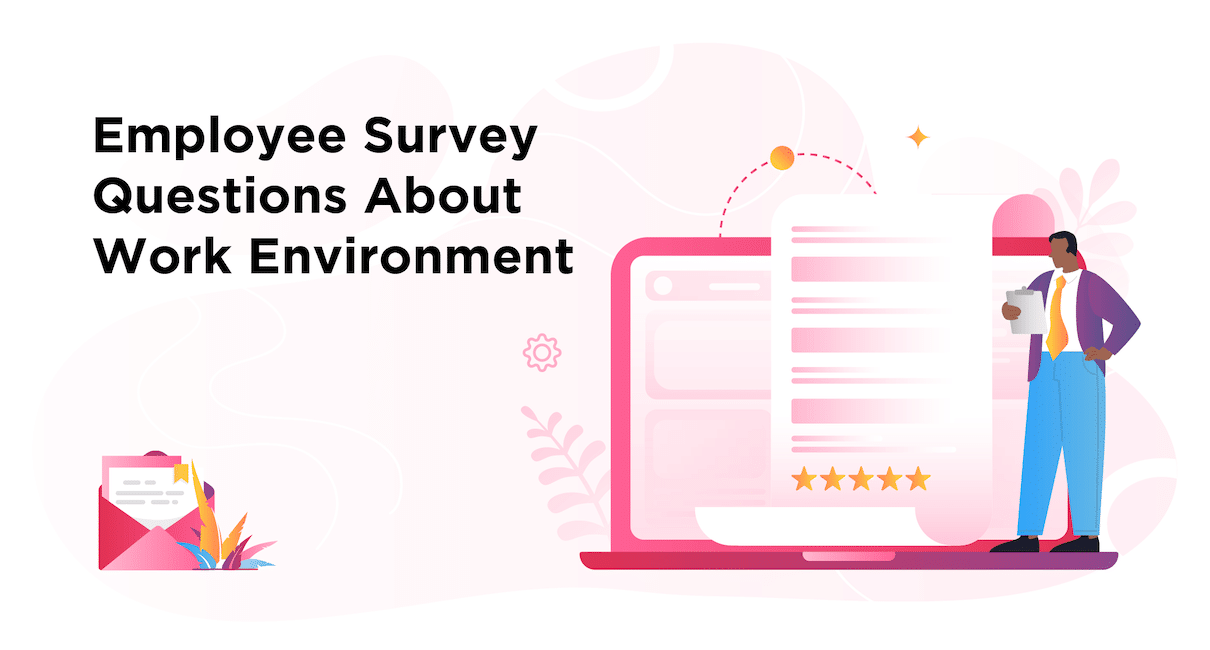With more remote workers than ever before, internal communicators need a fast way to gather employee feedback. Employee pulse surveys offer an easy-to-implement solution for gathering quick, quality feedback.
Collecting employee feedback is an easy decision; you collect valuable insight while your employees voice their opinions and feel heard. But not all employee feedback is the same.
Savvy internal communicators have a selection of feedback collecting methods at their disposal and employ the one best suited for the current task. Pulse surveys may represent the shortest variety of employee surveys, but their value is massive.
By the end of this blog, you’ll be an expert in sending employee pulse surveys and know exactly how they fit into your overall internal communications strategy.
What is an Employee Pulse Survey?
If you’ve worked a day in the corporate office, you’ve probably heard the word “pulse survey” a dozen times. But what is the purpose of a pulse survey?
An employee pulse survey is a short, focused question about a pertinent workplace topic.
This type of survey is usually included alongside other communications like employee emails and newsletters. The other communications help to contextualize the survey.
Pulse surveys get their name from the idea of a “pulse check”; a way to quickly gauge how your employees feel about any given issue.
Benefits of an Employee Pulse Survey
With a hybrid or remote workforce, you don’t have the luxury of simply walking across the hall to ask for your colleagues’ opinion.
Using an employee pulse survey—with carefully crafted employee opinion survey questions—you can quickly get the input you need from your remote workers—all they have to do is check their email.
The biggest advantages of employee pulse surveys lie in their short format. Here are just a few key capabilities of this type of survey:
- Allows you to check in with employees more regularly without overwhelming them.
- Improves survey completion rate as it’s easier for employees to fill out these quick questionnaires.
- Track patterns and changes in in-person and digital employee experience and perspectives over time.
- Act faster on employee suggestions and feedback.
These advantages make employee pulse surveys especially effective for measuring employee engagement, checking whether staff received key company updates, and gauging reactions to change management.
Analyze and understand your pulse survey results.
Get ContactMonkey’s powerful analytics and reporting.
Why Should Internal Communicators Use Employee Pulse Surveys?
When it comes to making informed decisions, internal communicators rely on employee feedback to get an idea of any potential issues. After all, your employees are in a unique position to offer key insights about their work. Here are just a few key reasons why you need to conduct employee pulse surveys:
Prevent long-term problems: gather input on company changes to prevent issues from slipping through the cracks
- Make collecting feedback more efficient: employees can read and answer most pulse surveys in less than 30 seconds.
- Improve productivity: employees who are engaged in their work are more productive, deliver better customer service, and have greater brand loyalty.
- Make employees feel heard: employee pulse surveys show that you value employee feedback.
- Improve customer loyalty: employees who are engaged in their work are more productive, deliver better customer service, and have greater brand loyalty.
- Foster a workplace culture of continuous improvement: by consistently gathering insights on how employees feel, you’ll be able to stay ahead of the curb when it comes to workplace engagement and retention.
Must-Have Pulse Survey Templates
Employee pulse surveys don’t have to completely replace annual employee surveys. In fact, they can serve as a nice complement to the larger data set that the annual version would leave you with. With ContactMonkey, pulse survey design is made easy through a range of preset employee pulse survey examples and a library of ready-made templates.
Pro Tip: Organize and segment employee sending lists to target the right employees with the right questions using ContactMonkey’s list management tool.
Best of all, every survey is embedded directly into your employee newsletter. This makes your surveys not only more accessible to employees, but allowing you to capture a range of employee engagement data related to your surveys.
ContactMonkey’s OpenAI integration even lets you generate new employee survey questions straight from your newsletter for faster survey design and implementation.
Here are just a few employee survey templates to incorporate into your pulse survey strategy.
1. Management pulse survey template

2. Work/life balance pulse survey template
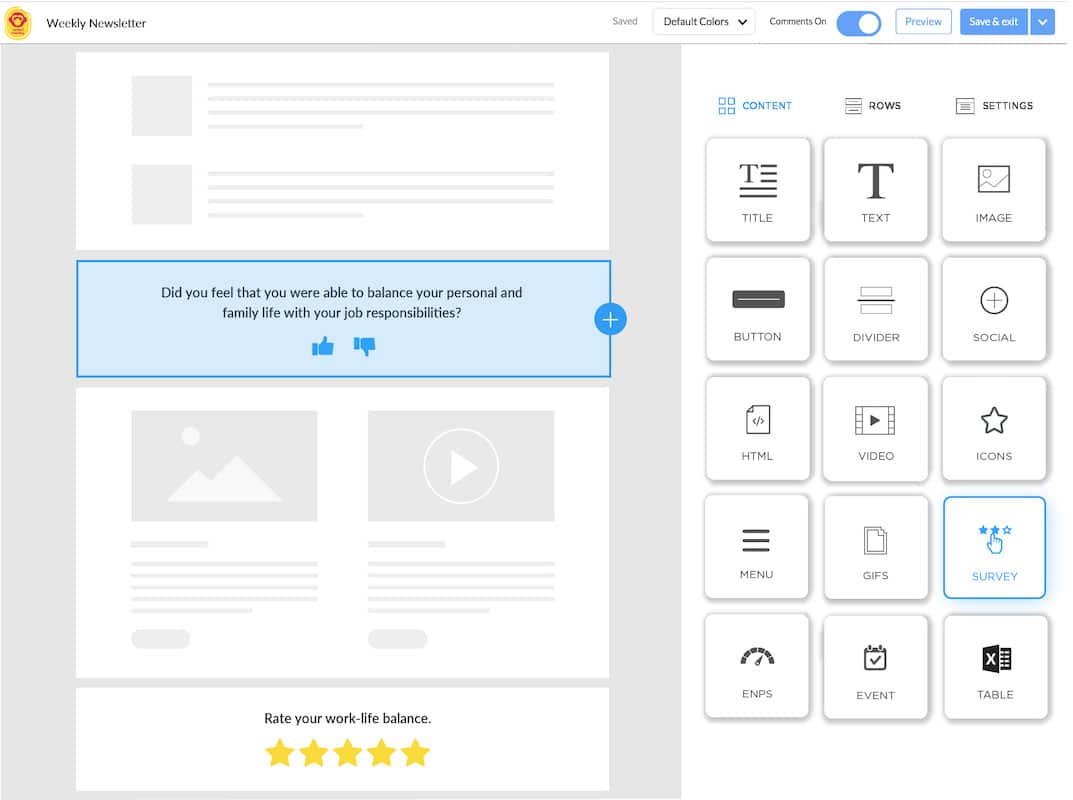
3. Company culture pulse survey template
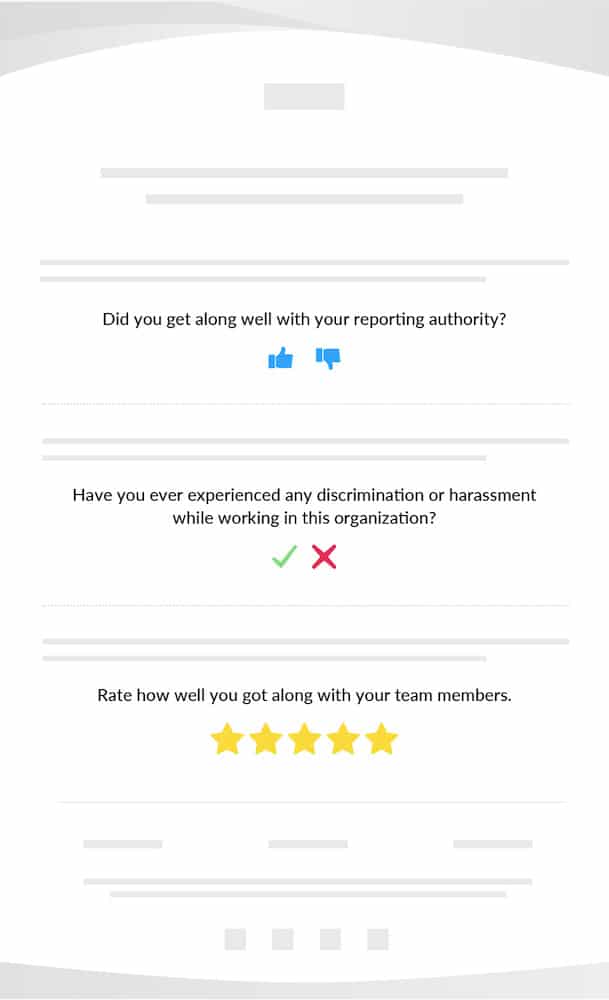
4. Professional development pulse survey template

5. Employee exit survey template

How To Use Employee Pulse Surveys
Asking a short question in your employee emails may seem easy because it is. But to gather actionable, leadership-persuading information from your employees, you’ll need a strategy for your employee pulse surveys.
1. Choose the right questions
It’s not always easy to find how to ask employees for feedback. But the right question can be the difference between a prompt response and a blank answer.
When choosing pulse survey questions, keep in mind the following factors:
- The object of the employee survey question that you’re sending out.
- The style of survey that you want to send, either a single question or a few.
- The timeline that you are giving for survey responses.
- The sample size completing the employee survey.
- The scale you’re using for employee response.
That last point is important. Employee pulse survey response scales refer to the kind of response your employees can give to a question. The scales you can use to inspire your questions include:
Likert Scales
Likert Scale-style questions are used to determine the strength or intensity of an attitude. They typically offer five options in a range, but can go up to seven.
A common example is a rating range, like star ratings. Not only are they used for measuring agreement statements, but Likert scales also work well for:
- Frequency
- Quality
- Importance
- Likelihood
Likert Scale-style questions are super easy to use with a pulse survey tool like ContactMonkey. With emoji reactions and star ratings, you can gather feedback featuring a range of replies:

Dichotomous Scales
Dichotomous questions have two possible answers. They can be as simple as yes/no, agree/disagree, true/false, and more.
With ContactMonkey you can easily add yes/no, thumbs up/down, and other dichotomous scale-style questions to your employee emails:

2. Give notice about the survey to employees
Don’t take employees by surprise with the pulse survey. Let them know when to expect the survey and how their feedback will be handled. Always choose transparency.
Ensure feedback is anonymous
When you send pulse surveys with ContactMonkey, employee anonymity is guaranteed. Employee pulse survey responses are never associated with an email address or username.
Your employees can feel free to share their honest feedback without fear of repercussions. If your staff want to elaborate on their pulse survey responses, you can enable anonymous commenting on your internal emails.
After responding to your survey, employees will be given the option to provide additional comments. Similarly to survey responses, employee comments are never associated with a name or email address.
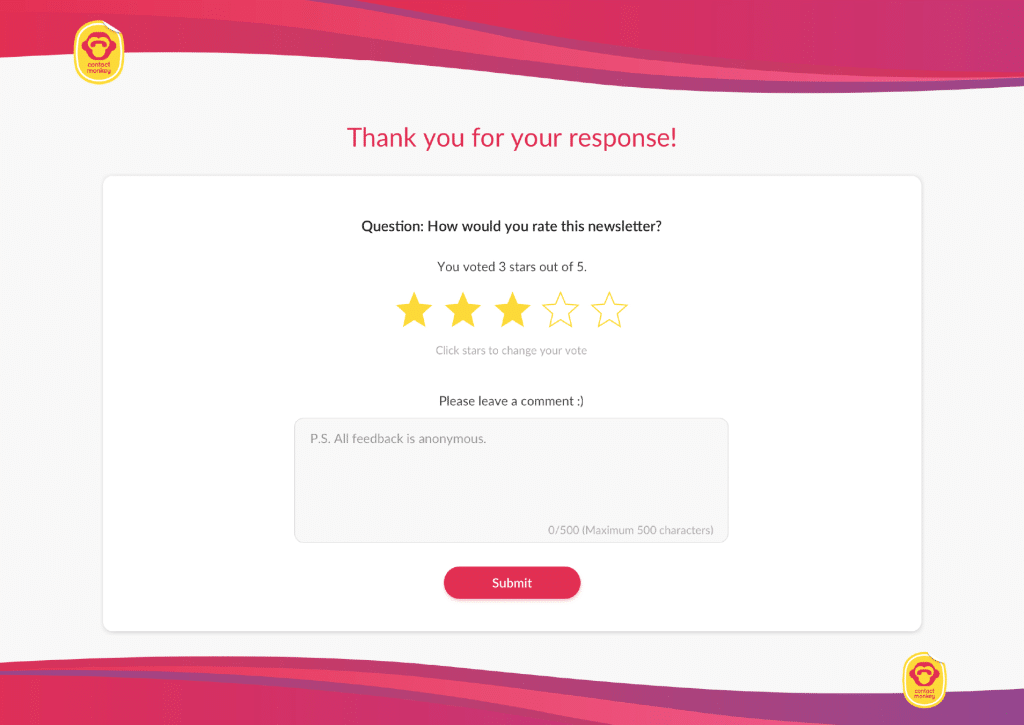
3. Time your surveys perfectly
Send the pulse survey out at a time that considers employees’ time. Make sure that it’s given in a way that is convenient for them to complete.
Consider how you send it out also; are you sending at times when they’re most likely to read and respond?
If you don’t know what’s a good average open time for your industry, you can use ContactMonkey’s Internal Benchmark Report for 2023 to see how your business stacks up against others in your industry.
Using ContactMonkey’s email tracking you can find the times when your employees’ email engagement is highest to improve employee survey response rates. Then, with scheduled sending, you can ensure your emails arrive in your employees’ inboxes at the best possible time

In addition to sending emails at times when your employees are most likely to open them, you can boost your open rates in other ways.
With ContactMonkey’s merge tags, you can personalize your email subject line according to who is receiving it. Custom subject lines are very effective, which is why EPS Water uses ContactMonkey to boost responses on their emails.
Using ContactMonkey’s HRIS integration, you can also leverage your existing employee contact lists, organize and segment audiences, and create tailored email content.
4. Evolve your pulse survey questions
Have a strategy for your pulse survey questions. Your strategy can outline who receives which surveys when, and this can help immensely when measuring your overall employee engagement.
For example, you can separate who receives your pulse surveys based on seniority. Create distribution lists based on how long employees have been at your company, and send them pulse survey questions tailored to that.
Not only will this give you a breakdown of employee engagement by seniority, but it allows you to create pulse survey question cadences for your employees. Begin with questions aimed at gauging all-around engagement, and then hone in on particular topics as your employees accrue experience at your business.
What To Do With Employee Pulse Survey Results
Employee feedback is invaluable driving employee engagement via internal communications. Not only can you gather feedback about specific issues or questions, you can also gauge how engaged your employees are with your emails.
Determine areas of concern and opportunity
Using employee pulse survey results in conjunction with your email stats can provide invaluable insights.
Example: you send out a pulse survey for employees about a common topic. However, when you check how it’s performed you see that employee response is enormous; the open rate and number of pulse surveys responses are through the roof.
An outsized response can indicate a topic that needs to be addressed, providing you content for further pulse survey questions.
With ContactMonkey, you can go one step further. Segmented email stats let you see how email engagement breaks down according to section or division, job title, and office location:

See what questions matter to which parts of your company, and send relevant questions to the right place with ContactMonkey.
Gather employee pulse survey analytics
In addition to the employee responses to your pulse surveys, you should also look at the email tracking stats for emails containing pulse surveys.
Metrics like open rate, click-through rate, opens by device and location, and read time can give you a detailed picture of employee engagement. These stats show how employees are engaging with your pulse surveys.
Using ContactMonkey, all of your pulse survey email stats can be viewed on your analytics dashboard:
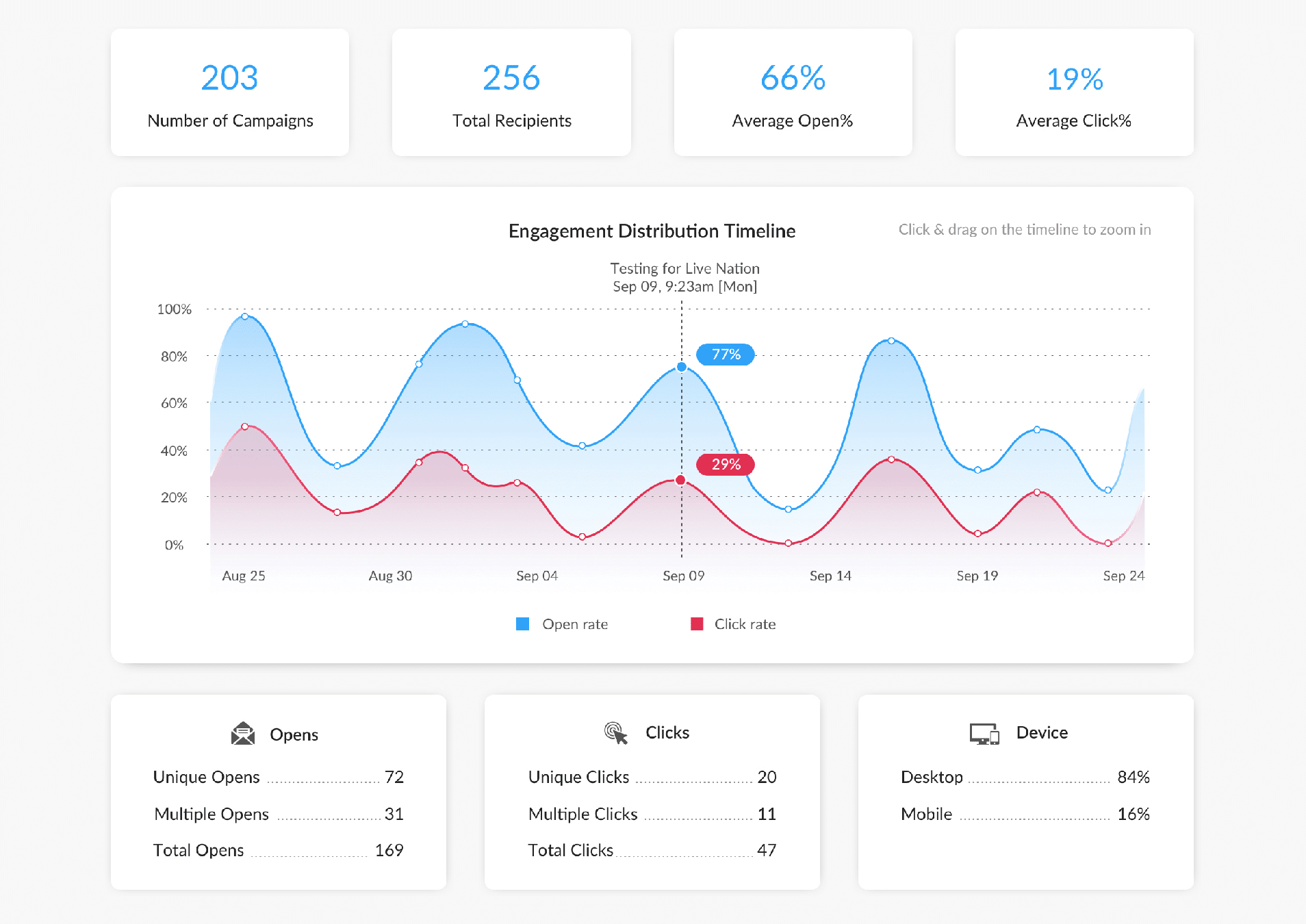
Share results with your employees
Put some time aside to share your employee survey results with employees, even if it’s just at a high level. Be clear about your pulse survey objectives. This will reassure your employees that managers take feedback seriously.
It also provides an open forum for employees to ask any questions they may have.
If you set the tone for sharing results, they’ll be even more enthused to respond going forward, which will positively influence response rates and employee engagement.
Best Practices for Employee Pulse Surveys
Whether you’re conducting an employee engagement pulse survey or an employee exit survey, there are a few common criteria all great pulse surveys have in common. Below, we’ve broken down a few best practices in pulse surveys to keep in mind:
Outline the purpose or goal of your employee pulse survey
The most important thing to do before designing your employee survey, is asking yourself, “what is the purpose of my pulse survey?”
Is the objective of your pulse survey to increase employee satisfaction with your benefits package? Is the long-term goal to improve employee morale across your organization? Or, is your goal to boost engagement in a particular department?
When you’re able to answer these questions for yourself, you’ll be able to narrow down your pulse survey audience, determine the right questions to ask, and pick the right frequency for your survey.
Make input matter
When employee feedback isn’t taken seriously, pulse surveys start to lose their effectiveness. As a result, employee engagement will also be affected.
“The most typical reason people don’t want to fill out your [employee] survey is because you haven’t done anything since the last one. They don’t have survey fatigue; they have lack-of-action fatigue.” – Didier Elizinga, CEO of Culture Amp
Be open and up front with your employees. Tell them why you’re sending them the surveys, take care in creating the right questions for your pulse survey, make sure length and frequency of distribution are reflective of one another, and use analytics to truly understand the data you’ve collected.
Once you nail down your pulse survey cadence, you’ll start to collect more relevant feedback, gather meaningful insights, and give employees confidence that leadership takes their opinions seriously.
Because they’re so quick to complete, pulse surveys usually glean a higher response rate, boost morale, and promote a culture around open communication.
Keep it confidential
We mentioned previously how pulse surveys can stand in for face-to-face conversations in an office setting. While this is true is many cases you have several advantages when you use an employee pulse survey.
The biggest benefit of a pulse survey is being able to offer employees the choice to respond anonymously—this can even be done by creating anonymous surveys.
Anonymous feedback helps internal communicators increase engagement with their surveys.
Employees are less hesitant to respond when they know their identity is protected, and the promise of anonymity can encourage the most candid feedback possible.
When you enable comments on your emails with ContactMonkey’s anonymous employee commenting, your employees will have the option to leave a comment after they respond to your pulse survey. Their comments are shown directly below your survey results:

You can also use ContactMonkey’s analytics dashboard to track open rate, click-through rate, opens by device and location, read time, and more via your employee emails.
Use in-depth metrics to find your best performing content, your most engaged branches or divisions, and so much more.
Prove the value of leadership communications and the ROI of employee engagement by showing exactly how much your email open rates have increased, or how many survey respondents you get.
Establish a pulse survey cadence
You can conduct employee pulse surveys as often as once a week. That’s the great thing about pulse surveys – they’re short, simple, and don’t take up too much of your employees’ time. Especially, if they’re already embedded into employee emails – your staff can complete them on their way to a meeting, or while lining up for coffee.
However, if you’re going to ask your employees to complete a pulse survey that often, then you must be prepared to take some sort of action.
It’s vital to send out pulse surveys only as fast as you’re able to act on their results. If you’re constantly sending out surveys but employees don’t see any action being taken, it won’t be long before they begin to ignore them. Try to set up a regular cadence, or ‘flow,’ for your surveys.
This will help employees know when to expect your survey and also give your surveys a logical order. We recommend sending out your pulse survey every 2-3 weeks depending on the topic.
For instance, if it’s benefits enrolment season, it might be a good idea to conduct an employee benefits survey. But make sure you can at least respond or act on some of the results ahead of your next survey.
How to Create an Employee Pulse Survey: Step-by-Step
Creating an employee pulse survey using ContactMonkey is super easy.
First, create a row on your email template where you’d like to insert your survey question. We recommend using an entire row for your question so that it can be easily seen:

Drag the survey tile onto your row and click Select Surveys. Here you can choose what kind of feedback you’d like to collect with your pulse survey template:

Once you’ve selected your pulse survey, you then drag the text tile into the same row as your survey. Make sure it’s placed into the same row to ensure your question is linked with the pulse survey responses. Here’s a pulse survey example to give you an idea:
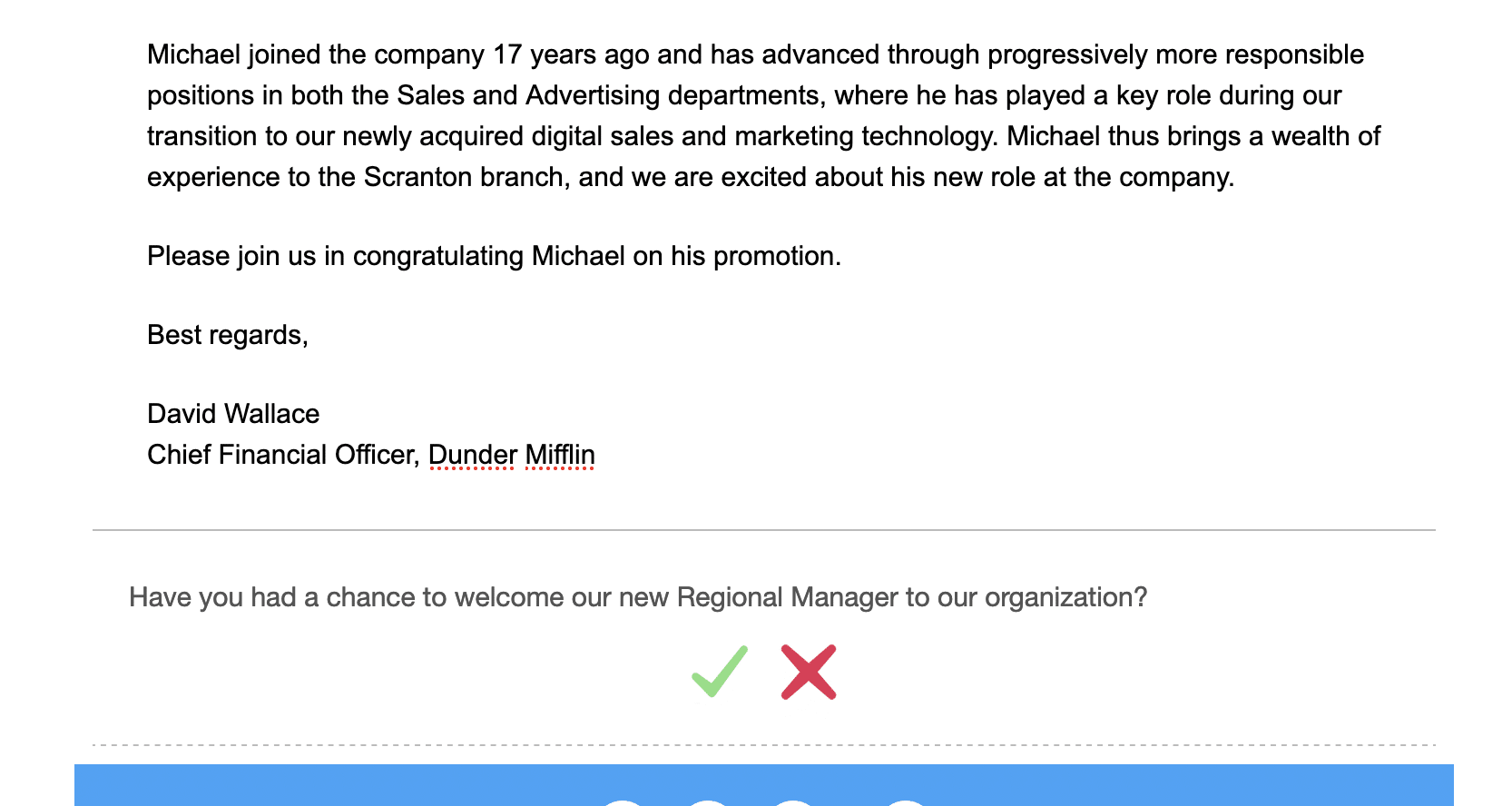
And it’s as simple as that! You’ve successfully embedded a pulse survey into an internal email. Using ContactMonkey, you can create saved pulse survey templates that you can reuse to save time on your email creation. Make pulse surveys a regular part of your internal communications strategy to boost employee engagement and collect better employee feedback.
Best Pulse Survey Software
After reading this guide, you may think you have a tall order ahead of you. We’re not going to lie, designing, analyzing, and acting on employee pulse surveys is no small feat. Especially if you’re doing it all on your own. Luckily though, you don’t have to.
There are many different types of employee engagement pulse survey software on the market. And all of them are designed to help you instantly create, send, track, and even analyze pulse survey data.
Here are 10 of our favourite, tried and true employee engagement pulse survey tools:
- ContactMonkey
- OfficeVibe
- TinyPulse
- SurveyMonkey
- WorkTango
- Leapsome
- Empuls
- Workvivo
- Quantum Workplace
- Assembly
Why Create Pulse Surveys With ContactMonkey?
With ContactMonkey, you can try employee newsletter ideas like creating a culture of feedback via smartly-placed pulse surveys.
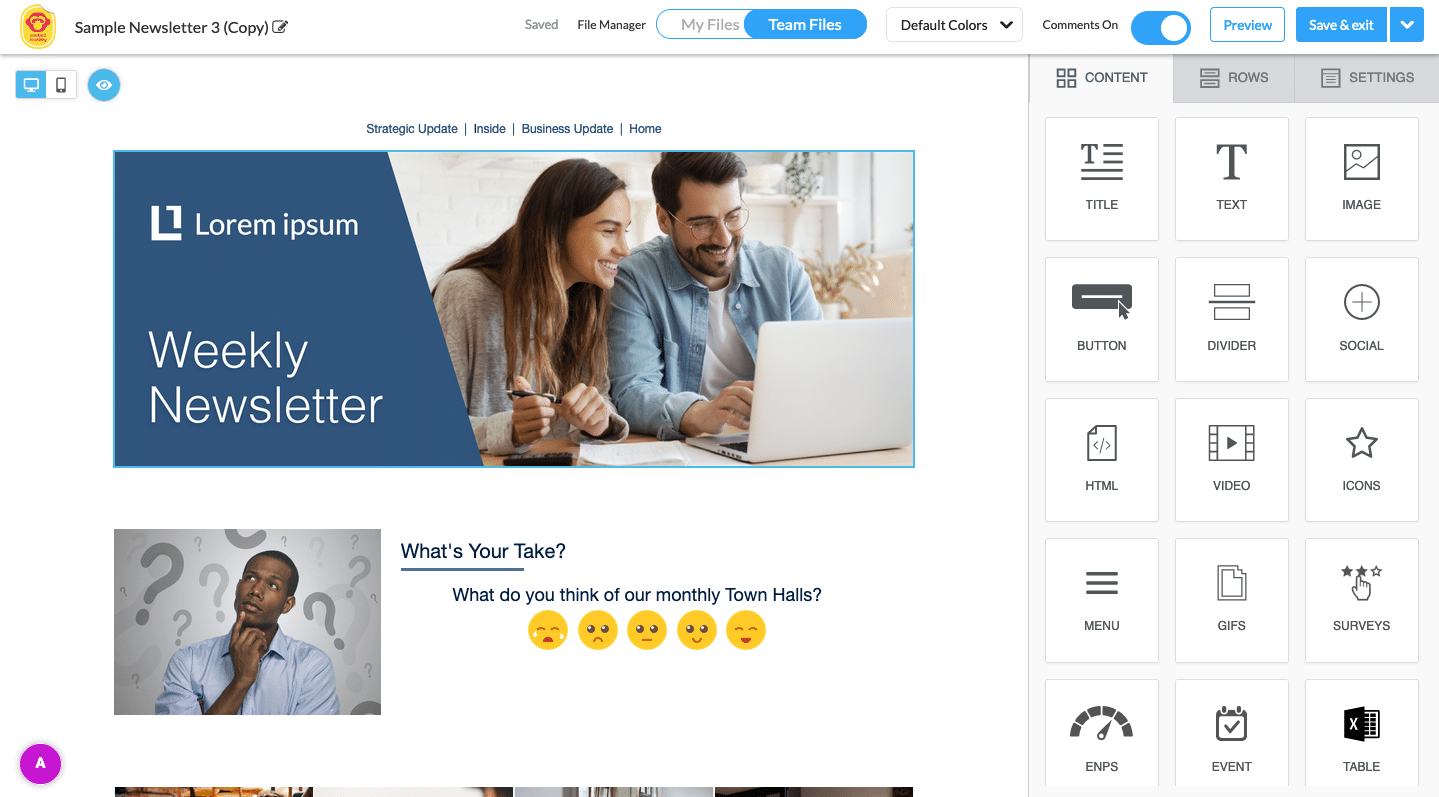
Our drag-and-drop email template builder lets you create beautiful HTML emails that allow your employees to respond to pulse surveys from whatever device they’re viewing from. Gathering feedback about your business to learn how to best engage your employees:
But creating great-looking employee surveys is only half of the employee engagement picture. You need to act on your employees’ input too.
Collecting employees feedback via an employee engagement tool is a win-win for your internal communications. All of your email engagement analytics as well as your survey response data can be found in a single, easy-to-use dashboard.
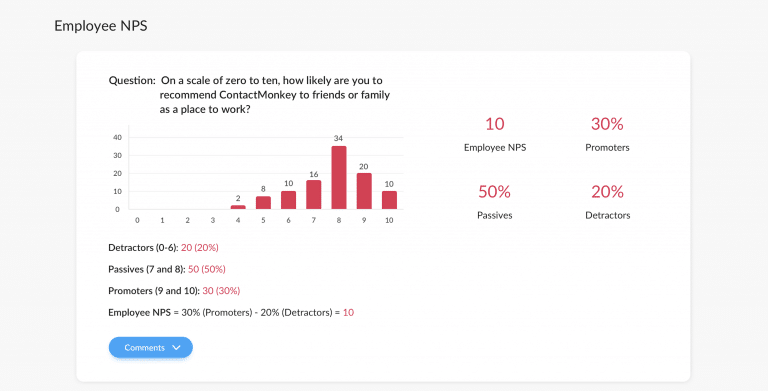
Sometimes, employees will need more than a simple “yes” or “no” to properly answer a question. Though brief, employee pulse surveys can elicit a wide-range of responses from your employees.
When you use ContactMonkey for your pulse surveys, you can choose between surveys based on dichotomous or Likert Scale questions.
Emoji reactions, eNPS surveys, and star ratings let employees respond to question on a scale of answers. Yes/no and thumbs up/down let employees respond via a dichotomy. Both are easy to embed using ContactMonkey’s email template builder:

Collect a variety of feedback and get better answers to your questions by using the right pulse survey. Your employees will thank you!
href=”https://cta-redirect.hubspot.com/cta/redirect/6282300/9421279e-f59a-47da-9d30-b32b96e2d0db” >
Better, Easier Pulse Surveys with ContactMonkey
As internal communicators, you need to give employees easy opportunities to provide feedback and express their ideas. This feedback can inform how you approach internal communication and employee engagement activities.
Regularly featuring non-intrusive surveys within your employee emails or newsletters gives those employees inclined to respond a chance to make their voice heard, and perhaps less vocal employees a chance to add their thoughts anonymously.
With ContactMonkey you can easily create, send, and track employee pulse surveys within Outlook and Gmail. Get quality employee feedback, gather email stats, and show hard data to support the efficacy of your internal communications strategy.
Ready to see how these seemingly small changes can have a big impact on employee engagement levels? Schedule a free demo of ContactMonkey today!



